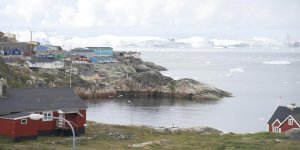| News / Science News |
Certain Arctic lakes store more greenhouse gases than they release
NSF | JULY 20, 2014
New research counters a widely-held scientific view that thawing permafrost uniformly accelerates atmospheric warming, indicating instead that certain Arctic lakes store more greenhouse gases than they emit into the atmosphere.

Thermokarst lakes occur as permafrost thaws and creates surface depressions that fill with melted freshwater. Credit: Katey Walter Anthony / University of Alaska Fairbanks
The study focuses on thermokarst lakes, which occur as permafrost thaws and creates surface depressions that fill with melted fresh water, converting what was previously frozen land into lakes.
The research suggests that Arctic thermokarst lakes are "net climate coolers" when observed over longer, millennial, time scales.
"Until now, we've only thought of thermokarst lakes as positive contributors to climate warming," said lead researcher Katey Walter Anthony, associate research professor at the University of Alaska Fairbanks Institute of Northern Engineering. "It is true that they do warm climate by strong methane emissions when they first form, but on a longer-term scale, they switch to become climate coolers because they ultimately soak up more carbon from the atmosphere than they ever release."
The researchers observed that roughly 5,000 years ago, thermokarst lakes in ice-rich regions of North Siberia and Alaska began cooling, instead of warming the atmosphere.
While methane and carbon dioxide emissions following thaw lead to immediate radiative warming, carbon uptake in peat-rich sediments occurs over millennial time scales.
Using published data from the circumpolar Arctic, their own new field observations of Siberian permafrost and thermokarsts, radiocarbon dating, atmospheric modeling and spatial analyses, the research team studied how thawing permafrost is affecting climate change and greenhouse gas emissions.
Researchers found that thermokarst basins switched from a net radiative warming to a net cooling climate effect about 5,000 years ago. They found that high rates of carbon accumulation in lake sediments were stimulated by several factors, including thermokarst erosion and deposition of terrestrial organic matter, nutrient release from thawing permafrost that stimulated lake productivity, and by slow decomposition in cold, anoxic lake bottoms.
These lakes are being fertilized by thawing yedoma permafrost. Yedoma is a type of permafrost that is rich in organic material. So mosses and other plants flourish in these lakes, leading to carbon uptake rates that are among the highest in the world, even compared to carbon-rich peatlands.
The study also revealed another major factor of this process: when the lakes drain, previously thawed organic-rich lake sediments refreeze. The new permafrost formation then stores a large amount of carbon processed in and under thermokarst lakes, as well as the peat that formed after lake drainage.
Researchers note that the new carbon storage is not forever, since future warming will likely start re-thawing some of the permafrost and release some of the carbon in it via microbial decomposition.
As roughly 30 percent of global permafrost carbon is concentrated within 7 percent of the permafrost region in Alaska, Canada and Siberia, this study's findings also renew scientific interest in how carbon uptake by thermokarst lakes offsets greenhouse gas emissions. Through its data collection, the study expanded the circumpolar peat carbon pool estimate for permafrost regions by more than 50 percent.
YOU MAY ALSO LIKE



